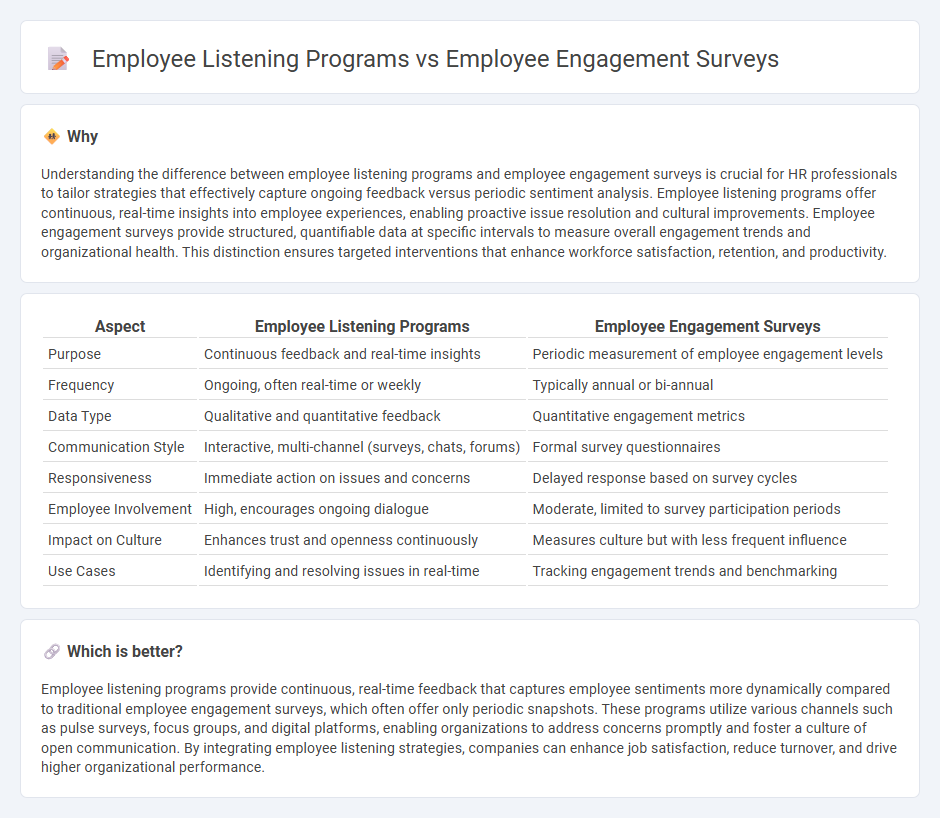
Employee listening programs gather continuous, real-time feedback through multiple channels to understand workforce sentiment and improve organizational culture, while employee engagement surveys typically provide periodic snapshots measuring overall job satisfaction and commitment. Effective listening initiatives enable companies to address employee concerns promptly and foster a more agile, responsive work environment. Discover how integrating both approaches can transform your HR strategy and boost employee experience.
Why it is important
Understanding the difference between employee listening programs and employee engagement surveys is crucial for HR professionals to tailor strategies that effectively capture ongoing feedback versus periodic sentiment analysis. Employee listening programs offer continuous, real-time insights into employee experiences, enabling proactive issue resolution and cultural improvements. Employee engagement surveys provide structured, quantifiable data at specific intervals to measure overall engagement trends and organizational health. This distinction ensures targeted interventions that enhance workforce satisfaction, retention, and productivity.
Comparison Table
| Aspect | Employee Listening Programs | Employee Engagement Surveys |
|---|---|---|
| Purpose | Continuous feedback and real-time insights | Periodic measurement of employee engagement levels |
| Frequency | Ongoing, often real-time or weekly | Typically annual or bi-annual |
| Data Type | Qualitative and quantitative feedback | Quantitative engagement metrics |
| Communication Style | Interactive, multi-channel (surveys, chats, forums) | Formal survey questionnaires |
| Responsiveness | Immediate action on issues and concerns | Delayed response based on survey cycles |
| Employee Involvement | High, encourages ongoing dialogue | Moderate, limited to survey participation periods |
| Impact on Culture | Enhances trust and openness continuously | Measures culture but with less frequent influence |
| Use Cases | Identifying and resolving issues in real-time | Tracking engagement trends and benchmarking |
Which is better?
Employee listening programs provide continuous, real-time feedback that captures employee sentiments more dynamically compared to traditional employee engagement surveys, which often offer only periodic snapshots. These programs utilize various channels such as pulse surveys, focus groups, and digital platforms, enabling organizations to address concerns promptly and foster a culture of open communication. By integrating employee listening strategies, companies can enhance job satisfaction, reduce turnover, and drive higher organizational performance.
Connection
Employee listening programs and employee engagement surveys are interconnected tools essential for measuring workforce sentiment and identifying areas for organizational improvement. Engagement surveys provide quantitative data on employee satisfaction, while listening programs offer qualitative insights by encouraging open dialogue and continuous feedback. Together, they drive strategic decision-making, enhance workplace culture, and improve overall employee retention rates.
Key Terms
Employee Engagement Surveys:
Employee Engagement Surveys provide structured, periodic assessments that measure employee satisfaction, motivation, and commitment through standardized questions and quantitative data analysis. These surveys identify key drivers of engagement, enabling organizations to track trends over time and implement targeted interventions for improving workplace culture. Explore the detailed benefits and implementation strategies of Employee Engagement Surveys to enhance organizational performance.
Survey Feedback
Employee engagement surveys primarily collect structured feedback at set intervals to gauge overall employee satisfaction and sentiment, while employee listening programs continuously gather real-time input through various channels for a dynamic understanding of workplace concerns. Survey feedback in engagement surveys provides quantifiable metrics to identify trends and areas for improvement but may lack the immediacy and depth of ongoing dialogue found in listening programs. Explore how integrating both approaches can enhance organizational responsiveness and foster a more connected workforce.
Engagement Metrics
Employee engagement surveys typically measure specific engagement metrics such as job satisfaction, commitment, and motivation through periodic questionnaires. Employee listening programs offer continuous feedback channels like pulse surveys, focus groups, and real-time sentiment analysis to capture dynamic employee experiences and improve workplace culture. Explore how integrating both approaches can enhance your talent management strategy.
Source and External Links
Employee Engagement Surveys: Ultimate Guide - This guide provides 24 powerful example questions for employee engagement surveys, helping to address individual empowerment, team alignment, and organizational growth.
Employee Engagement Surveys: The Questions to Ask & ... - Offers tips, templates, and sample questions to create effective employee surveys, boosting engagement and reducing attrition.
Employee Engagement Survey Questions - Provides a set of questions for an employee engagement index, including pride, recommendation, commitment, and motivation.
 dowidth.com
dowidth.com